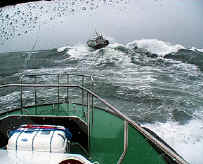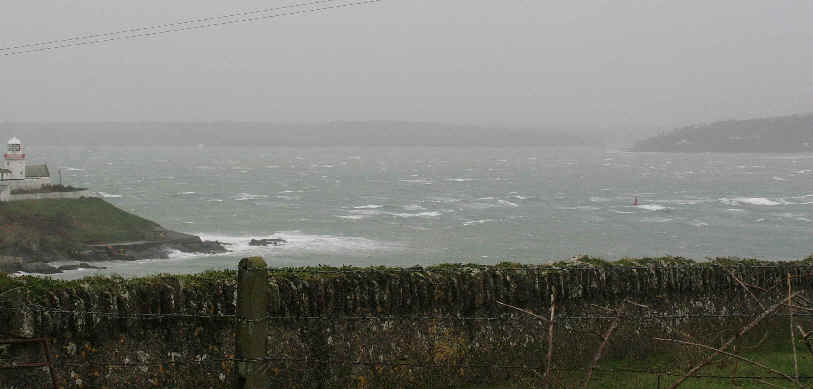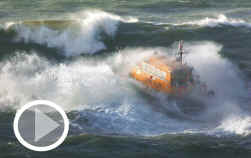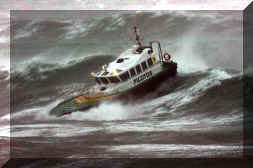| VIDEO
PRODUCTION How and where we capture the spectacular footage for our video's
|
|||||
|
HISTORY OF SAFEHAVEN MARINE PILOT BOATS
NEW VESSELS & PILOT BOATS UNDER CONSTRUCTION
TESTIMONIALS & REFERENCES FORM PAST CLIENTS
See all our previous professional PILOT vessels
See our spectacular rough weather video's
See our recent newsletter
MAGAZINE ARTICLES INDEPENDENT BOAT TEST ON THE INTERCEPTOR 55 BY DAG PIKE MOTOR BOAT AND YACHTING ARTICLE - STORM FORCE 11
|
TAKING THE VIDEO'S Videos are taken from Roches Point light house at the entrance to Cork Harbour, the lighthouse is situated about 100ft above the cliffs, and gives a clear vantage point of the sea and harbour entrance. The harbour entrance can create some spectacular and dangerous seas, in wind over tide conditions the Atlantic swell meets an outgoing tide causing the waves to become very steep and break heavily at the mouth of the harbour, in storms I they can break continuously for 3-400 yds creating a carpet of foam. At the entrance is also the harbour rock, situated between the Channel buoys, and over this, when the waves are big (over 5m) the swells break. When taking the videos we are able to verify the wind speed with the weather station at Roches point, wave heights I verify with the Marathon gas platform 20nm of the coast, If the platform is recording swell heights of 7m in deep water, those same swells will probably be more at the entrance in ebb tides (we try to time the video to occur in the ebb to capture the worst conditions) There is such a huge difference in sea state between flood and ebb conditions at the harbour mouth that I estimate a force 6-7 blow with wind against tide creates a worse and more dangerous sea state than a full force 8 gale offshore. As the ebb runs its cycle it creates eddies that move around the harbour mouth, creating spots where the overfalls and waves are worse. Wind direction plays a big part, the worst conditions occur in SE, S, and SSW, when it veers to the SW the seas go down, but it could still be blowing force 8 or 9. One point to bear in mind is that the waves never look so big from a high vantage point, but if you can't see the top of the boats mast when your 100ft above the sea, then you know that it was a big wave. From the boat conditions and motions can be extreme. When doing the videos, up to about force 8 you can actively, within reason look for the bigger waves, We trust the Interceptors abilities to be able to face these, and position the boat in a position to ride them. Above force 8 you have to look for the bigger seas and take them at a safe angle, force 9-10 can be can be pretty extreme to say the least, and the video we did in force 11 with hurricane wind speeds of 85kts certainly focused my mind! Occasionally a wave will appear that is over twice as big as the normal wave height, and on a couple of occasions we have caught this wave on video. Below, a big wave caught on a camera mounted on the mast of the boat. The camera is mounted between 4-5m above water, so its a good way of judging wave height, if the wave right in front of the boat is higher than the horizon in the video picture, it is as high or higher than the height of the camera above the water.
Right, the entrance to Cork harbour showing Roches Point lighthouse, left looking out over the sea, the cameraman is sheltered behind the walls as much as possible by the light house, top left of photo, generally the boat is around the red buoy and beyond, hence the long range lens.
We design and build our boats to operate in rough conditions, and the only way to be sure the boat is up to the task, is to actually do it. With a new hull design the only way you will truly know what she is like is take her out in to a gale, put her transom quarter on to a 10ft breaking wave and put the hammer down, then take your hands off the wheel and see what happens, you wont be long finding out! On new vessel sea trials, inevitably something will leak or fail, but you have the opportunity to expose it and sort it out, so that when the boat goes into service her owner will be able to handle the worst conditions with confidence. When taking the videos
the biggest problem can be camera shake, in 60-70mph gusts it is hard to
stand, let alone take good video footage, so a lot is unusable. The
camera stills are taken with a Canon EOS 1 and a 50-500mm lens. Two of my managers, Paul Pochopien and Kazek Bury take the videos and photos, and have become excellent at capturing the best moments. Generally its me (Frank) helming the boat, or when two boats are out Kieran Monks, Ian Brownlee and Gabrial Whitston driving the second boat. Recently we have started capturing some onboard footage using a camera on the mast in a waterproof housing and a surveillance type camera mounted on the bow, this involves following the boat in front quite closely and using the boat to aim the cameras, this can be pretty hairy, especially in extreme conditions, but it can produce some spectacular footage really giving an impression of the sea state and conditions.
Safehaven Marine, Ashgrove, Cobh, Co Cork, Ireland Phone 00353 86 8054582 Email- info@safehavenmarine.com safehavenmarine@eircom.net
|
All our vessels are build to the highest standards of strength & engineering and are renowned world wide for their exceptional sea keeping abilities. For the best, most extreme, rough weather demonstration videos of our boats, see our amazing selection on you tube.
BEST ROUGH WEATHER ACTION PHOTOS We don't just claim our boats have the best sea keeping abilities, here's the proof |
|||








